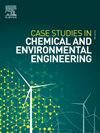The effect of mechanical milling and two-step sintering technique on the microstructure, microhardness, strength, and dielectric properties of Sm2Zr2O7 ceramics
Q1 Environmental Science
Case Studies in Chemical and Environmental Engineering
Pub Date : 2025-07-28
DOI:10.1016/j.cscee.2025.101270
引用次数: 0
Abstract
This paper investigates the effect of two-step sintering on the mechanical properties and microstructure of Sm2Zr2O7 ceramics obtained from submicron powders after high-energy milling. Two key parameters of the two-step sintering process are analyzed: temperature and duration, as both can significantly influence grain growth processes in ceramics. It was found that extending the sintering duration at lower temperatures promotes ceramic densification while preserving a relatively narrow grain size distribution. In contrast, higher sintering temperatures combined with shorter durations result in broader grain size distributions and more pronounced exaggerated grain growth. Despite differences in microstructure and grain size distribution, both the sample sintered at 1350 °C for 20 hours and the one sintered at 1700 °C for 10 minutes exhibited the highest mechanical properties, with microhardness values HV1 ∼1200 and biaxial flexural strength reaching ∼125 MPa. This suggests that the enhancement of mechanical performance may be linked to a reduction in internal stresses, either due to the elevated temperature during the first sintering step or the extended holding time during the second step. Thus, in both types of sintering, whether based on prolonged holding time or elevated temperature, changes in sample morphology and grain size do not appear to have a significant impact on the mechanical properties of the resulting ceramics.
机械铣削和两步烧结工艺对Sm2Zr2O7陶瓷显微结构、显微硬度、强度和介电性能的影响
研究了两步烧结对高能铣削亚微米粉末制备的Sm2Zr2O7陶瓷的力学性能和微观结构的影响。分析了两步烧结工艺的两个关键参数:温度和持续时间,因为这两个参数对陶瓷的晶粒生长过程有重要影响。结果表明,延长低温烧结时间有利于陶瓷致密化,同时保持较窄的晶粒尺寸分布。相反,较高的烧结温度和较短的烧结时间导致晶粒尺寸分布更宽,晶粒生长更明显。尽管显微组织和晶粒尺寸分布存在差异,但在1350℃下烧结20小时的样品和在1700℃下烧结10分钟的样品均表现出最高的力学性能,显微硬度值为HV1 ~ 1200,双轴抗折强度达到~ 125 MPa。这表明,机械性能的增强可能与内应力的降低有关,这可能是由于第一步烧结时温度的升高或第二步烧结时保温时间的延长。因此,在两种类型的烧结中,无论是基于延长的保温时间还是基于升高的温度,样品形貌和晶粒尺寸的变化似乎对所得到的陶瓷的机械性能没有显著的影响。
本文章由计算机程序翻译,如有差异,请以英文原文为准。
求助全文
约1分钟内获得全文
求助全文
来源期刊

Case Studies in Chemical and Environmental Engineering
Engineering-Engineering (miscellaneous)
CiteScore
9.20
自引率
0.00%
发文量
103
审稿时长
40 days
 求助内容:
求助内容: 应助结果提醒方式:
应助结果提醒方式:


